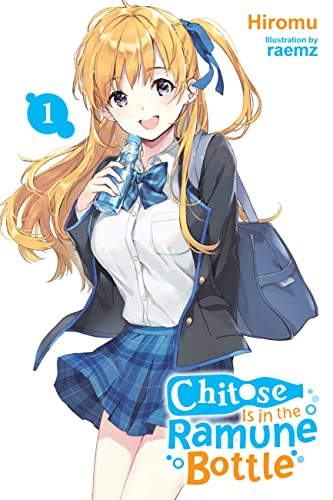By Hiromu and raemz. Released in Japan as “Chitose-kun wa Ramune Bin no Naka” by Gagaga Bunko. Released in North America by Yen On. Translated by Evie Lund.
Manga and light novel trends tend to feel into each other, with parodies, homages, and deconstructions of the hot new thing happening three years later and becoming the next hot new thing. Nowhere is this more apparent than the halls of Gagaga Bunko, home to the cover art where every series looks exactly the same. Gagaga, I’m sure, must also have fantasy and isekai titles… but those aren’t licensed here. Instead we started with My Youth Romantic Comedy Is Wrong As I Expected, where a cynical so-called loner psychoanalyses the nature of high school cliques. Then we saw Bottom-Tier Character Tomozaki, easily the most popular of the subgenre of “the popular kids can even turn you, a loser, into one of their own”. And now we get Chitose Is in the Ramune Bottle, where the main character IS the popular kid, and you will be surprised and shocked that he too has something to say on the nature of popular kids and high school cliques. Everyone’s riffing on someone else.
No, that’s not Chitose on the cover – Chitose Saku is our hero, a handsome cool high school kid who enjoys school and hanging out with his equally popular friends. He has several girls who are interested in him. He’s almost immediately made class president. He’s living the good life. And now he has a job to do, as the teacher has asked him to try to get Kenta, an otaku nerd type, to come back to school – he’s stopped going after getting shut down by a girl he confessed to. Chitose goes along with this, managing to get Kenta out of his room with a nice combination of encouragement, hot girl and good old fashioned violence. But Kenta, who whines about how Chitose gets everything handed to him and an easy life as a popular kid, decides to show Kenta how to actually make an effort.
As you can see, this synopsis bears more than a little resemblance to Tomozaki (Kenta is even named Yamazaki), and we do indeed get the “let’s shop for clothes that are not otaku schlub” and “here is how to actually converse with another person” scenes. At the same time, it also mocks that trend of “self-help” books as unrealistic, showing how difficult it can be to try to change your image and personality and not immediately get attacked. There’s a whole lot of jerks in this book, and the way Chitose and his friends handle them is a good look at “don’t punch down”. As for Chitose himself, he’s a protagonist who cries out for more than one book, so it’s a good thing this won an award and got a series. There’s hints of his past as well as his need to live up to his reputation that might get darker in later books. But overall, he and his friends are very likeable, fun people. If you’re reading this as you heard it was “romcom starring the popular kids”, you won’t be disappointed.
I will note that Chitose can come across – deliberately, he’s clearly doing it on purpose – as smug much of the time, and this may grate on readers who are more used to cynical sad sack narrators. That said, I am very curious to see how this handles being an ongoing series and how much we can peel back Chitose’s hero complex.


Speak Your Mind